| 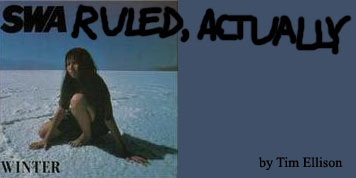
Hi,
it's me, Tim Ellison. I asked Larry Fuzz-O Dolman if he wanted
ta print this article I wrote on '70s U.S. psychedelia. I
wrote it for
another publication but they never printed it and so therefore
no one
ever got to read it because how could they read it if it never
got
printed? Larry said yes he would print it and it turns out
that we
are usin' it for the first installment of my new Blastitude
column
SWA Ruled, Actually.
People have probably
always considered there to be a rift in the history of psychedelic
music between the end of the ‘60s Zeitgeist and the
re-emergence of the aesthetic after punk rock (both with retro/revivalist
groups and neo-psychedelic stuffs). Naturally, though, psychedelic
music didn’t just disappear completely for a time in
1969 or so. A strange canon of North American records bridges
the gap between the original and latter day psychedelic musics
and allows you to look at the aesthetic as more of a cultural
continuum over this time.
Given
that psychedelic rock was not a popular American genre of
its own in the ‘70s, it’s interesting how various
groups scattered around the U.S. and Canada throughout the
decade nevertheless seem to constitute some kind of core ‘70s
psychedelic aesthetic. A self-titled album by an Indiana band
called Zerfas from 1973 perhaps provides
an early example of music that is primarily psychedelic in
orientation, but removed enough temporally from ‘60s
psych to seem unique.
Zerfas certainly
seem to have been influenced by ‘60s psych. Their song
“I Don’t Understand” is an absolutely classic
example of the segmented psychedelic song with juxtaposed
sections of varying instrumentation and tempos (including,
in this case, a gorgeous Badfinger-like chorus). “The
Sweetest Part” is a very righteous, accurate embodiment
of late ‘60s San Francisco sound, beginning with the
humorous couplet, “Think of all the good things that
happen every day/Wake up in the morning; find you haven’t
been blown away.”
Zerfas were not
just some band from the sticks who were lost behind the times,
though. Their album makes a case for itself as convincingly
current (ca. 1973) rock, but of a paradigmatically psychedelic
nature. The cool synthesizer solos on their track “Stoney
Wellitz,” for example, have much more to do with a ‘70s
aesthetic. Their greatest track, “I Need It Higher”
(a classic of this micro-genre), is not so far removed stylistically
from, say, the group America, but with elements of beauty
(the piano part, the compositional sophistication) and sinister-isms
(the wah-wah organ solo) that have much more to do with an
entrenchment in psychedelia.
Like a number
of other psychedelic records from the ‘70s, the level
of sophistication on the Zerfas album in the playing, arrangements,
and production quality is quite remarkable for some band from
Middle America recording an album on their own. If there had
been some sort of continued psychedelic movement and a market
for music like this, Zerfas would have been viable as a major
label act.
Slightly
less viable was a Canadian record (also self-titled) from
roughly the same time by a group called the Brazda
Brothers, led by two Eastern European immigrant siblings.
The Brazdas sing with fairly heavy accents in what sometimes
borders on a pidgin English, but as with lots of psychedelic
music from around the world in the ‘60s, this element
can add to the surrealistic quality of the record. Perhaps
primarily a folk-rock album, there are, strangely enough,
leftover ‘60s garage rock elements here and there. Their
most psychedelic track, “Gemini,” is an uptempo
minor key number with reverb-y organ and fuzz and wah-wah
guitar that sounds not unlike some classic Turkish psych.
The fact that theirs is, stylistically, a sort of lost music
makes their folk-rock stuff at its sweetest all the more haunting.
The album is very solid on the whole.
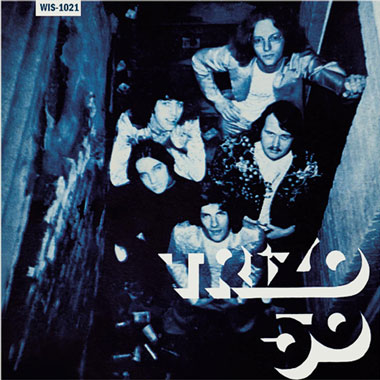
Another
group from the early/mid-‘70s that remains fairly *unheralded*
is the Missouri group Trizo 50, who also
released a self-titled album on a small label. The German
label World in Sound is currently in the process of releasing
a substantial amount of the group’s home-recorded music
in two volumes, the second of which will hopefully be out
any time now. The first volume (already released) features
a reproduction of the band’s album cover, but is, in
fact, not the same group of tracks as on the original LP.
Trizo 50 evolved
out of a group called Phantasia, who also released a couple
of records in the early ‘70s. Phantasia’s music
was very sophisticated in the psychedelic vein R. Meltzer
described as “academic beauty”: a kind of heavily
Romantic, poeticized music that was often heavy and downcast.
Phantasia songwriters John DePugh and Bob Walkenhorst were,
at one point, close to signing a contract to write songs for
Richard Harris of “Macarthur Park” fame!
While
some remnants of this style can be heard on the first volume
of Trizo 50 recordings released by World in Sound (including
the gorgeous “Hollyhocks”), those who know Phantasia’s
music through reissues of their records will be quite surprised
by what else Trizo 50 has in store. Influenced by T. Rex and
Bowie (both of whom they covered live), Trizo 50 wore glam
outfits and were definitely interested in the return to the
earlier spirit of rock and roll. While tracks like “Rock
Me, Roxie” and “Ride Me” sound like a type
of bubblegum glam, however, “Why Do You Do That to Me”
is full-on Nuggets ‘60s garage with gorgeous
background vocals (staggered entries like the Beatles doing
“Twist and Shout”). “Naughty and Nice”
is a minor key, Gothic garage psych gem that is a total of
one minute and thirty-nine seconds in length. What in the
world were these guys doing playing music like this in 1974?
Glam,
of course, is not antithetical to psychedelia. T. Rex and
Bowie were themselves coming out of psychedelic music. As
far as American groups go, the great Florida band White Witch’s
first album from 1972 is some kind of psychedelic prog/glam
nexus point. “Graveyard,” seemingly Trizo 50’s
greatest song, is a kind of wistful mid-seventies soft psych
epic that transcends their earlier Phantasia-era style. An
almost five minute long, beautifully orchestrated thing, “Graveyard”
is certainly a contender for the most gorgeous song on all
of these records.
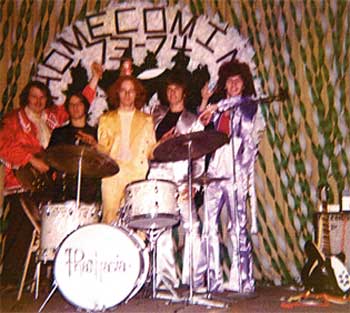
TRIZO 50 in their earlier incarnation as PHANTASIA
The true
master of brilliant U.S. ‘70s soft psych, Michael
Angelo, was also from Missouri (Kansas City). The
songs on his self-titled album from 1977 (plus other recordings
from the same period released later on) occasionally sound
a bit like Wings-style space pop rock and even Raspberries-era
Eric Carmen piano balladry. His songwriting was genuinely
at the level of these writers and the songs on his records
just continually hit one nail after another on the head. Angelo
also had a really good voice and an impressive scope of musicianship,
playing all of the instruments but drums himself and with
some real chops as a pianist and lead guitarist. His Gothic,
minor key, nine-eight ballad “Field of Lonely Eyes”
suggests a scope of psychedelic songwriting perhaps comparable
to that of Sean Bonniwell of the Music Machine (as in, for
example, the Music Machine ballad “Discrepancy”).
“Oceans
of Fantasy” (which, like Trizo 50’s “Graveyard,”
was included on the U.S. volume of the Love, Peace and
Poetry series and which is another contender for most
beautiful song on all of these records) is like the Love
Boat theme re-imagined as a psychedelic power pop ballad.
Angelo’s original, self-titled album is supplemented
by an LP released a few years ago on the Void label entitled
A Sorcerer’s Dream, which features a side of
eight tracks presumably from the same time frame as the album
(though probably from another album project that was never
completed—the songs are too good to have been outtakes!)
and a side of tracks in a somewhat different style recorded
in the eighties and nineties.

Michael
Angelo is commonly referred to as “Michaelangelo,”
by the way, and as such is one of the numerous one-named stars
in the world of rare, one man psychedelic LPs, along with
such figures as Darius and Marcus. Marcus
was a guy from Kentucky who released an album in 1979 entitled
From the House of Trax. As with Michael Angelo, this
is firmly ‘70s psych—nothing retro at all about
the sound (solid state gutar amps, synthesizers, etc.) The
album is just paradigmatically psychedelic from the get-go,
with spacey keyboards, lots of phase shifting, etc. Marcus’
lyrics are a mixture of spiritualism, science fiction, psychology,
concern for the foibles of mankind, and bizarre-o psychedelic
silliness like the following:
It
all started with a piece of light
So
small it could never be seen
It
turned into a universe
In
the window of a dream
It
amplified my mind
It
set me free to play
I
turned into a superstar
And
my mind has run away
There
is a sense of Gothic drama to much of the album and Marcus
is seen in photos wearing all black with a cross around his
neck and carrying a sword! (In other photos, he wears a white
robe and carries a staff.) Though his songwriting and singing
are not as good as Michael Angelo’s, this is another
album with quite nice, adept instrumental accompaniment. Part
of the appeal of some of these records, really, is that they
are period sounds done very well. The fact that they were
produced on a D.I.Y. basis makes them really impressive and
charming just on a human level.


MARCUS: The eternal interplay between the dark
and the light, Kentucky style.
New Englander
Bobb Trimble’s two LP records are from
slightly beyond the time frame of this article (early ‘80s),
but very definitely of this same genre: a then-contemporary
American psychedelic folk/pop-rock with modern production
and instrumentation. Bobb possesses a beautiful “elfin”
voice. A review of his second LP, Harvest of Dreams,
on the Lama Reviews psychedelic music web site states that
Bobb’s is “as beautiful a male singing voice as
there is in rock and roll.”
If Bobb’s
songwriting is not always as dynamic as Michael Angelo’s,
it perhaps nevertheless reaches greater heights, as in the
almost unbelievably beautiful six minutes of “Premonitions.”
(The Lama reviewer calls “Premonitions” “the
most exhilarating musical expression of love I’ve yet
heard.”) Bobb’s songs are impassioned, troubled,
but filled with light and beauty. Like Michael Angelo, Bobb
performed most of the instrumental parts on his two LPs himself,
and the accomplished nature of the result is, once again,
remarkable.
A CD
collection entitled Jupiter Transmission, released
in 1995 on the Parallel World label, collected most of the
music from Bobb’s two albums and an LP of unreleased
tracks (Life Beyond the Doghouse) was released in
2002 on the Danish Orpheus label. The latter record features
a couple of tracks from an apparent Jesus freak period. Even
here, though, Bobb is transcendent, especially on the almost
nine minute epic “Blood of the Lamb.” (Surely,
this is some of the weirdest “Christian psych”
ever. Is there even any ‘80s Christian psych other than
Bobb?) Life Beyond the Doghouse also features some
tracks Bobb recorded with a teenage backing band that are
much more ramshackle and goofy.

BOBB TRIMBLE: Gangsta shit.
One last
record of this genre (super psychedelic ‘70s U.S. pop!)
that should be mentioned is a late seventies album by Rick
Saucedo entitled Heaven Was Blue. Though
I have not heard this whole album, I have heard the eighteen-plus
minute title track suite that took up one side of the original
record and it is a truly sweet bit of over-the-top psychedelic
song composition. The playing is a lot more amateurish than
with the Angelo, Marcus, and Trimble records, but the compositional
inspiration is high and the track is very charming. Saucedo
was (and apparently still is) an Illinois-based Elvis impersonator,
but sings this psychedelic music in a high, twee voice! Saucedo
currently maintains a web site with numerous Elvis impersonation
CDs available via mail order as well as a CD pressing of this,
his lost ‘70s psychedelic classic!
Though
they are somewhat less psychedelic in orientation, albums
by the Milwaukee group Creme Soda and the
Los Angeles group Clap are more interesting
bridges between the ‘60s and the later explicit revival
of ‘60s aesthetics. As rock critic Greg Shaw noted in
the original liner notes to their 1975 Tricky Zingers
LP, Creme Soda made it seem like the whole phenomenon of American
“garage bands” had never died out. With a mixture
of simple R&R band arrangements and an eclectic stylistic
range, Tricky Zingers is like taking a pre-psychedelic,
1966 sense of rock and roll as an expanding form and transplanting
it into the middle of the ‘70s. Though they had numerous
musical directions, there is a simple, somewhat careless,
fun-spirited aspect to the group that is at the core of the
“garage” aesthetic. When Shaw made the claim in
the liner notes that Creme Soda were “the freshest new
sound of 1975,” it is surely to this that he was referring.
The album has
folk-rock elements that may have been based somewhat on ‘60s
music (“Give It up (Man)” is achingly beautiful
San Francisco psych style melodicisim), and they cover a Yardbirds
song, but there is plenty to this album that is just not germane
to the “garage band” style at all. “Keep
It Heavy” is some kind of crazy (and beautiful) power
pop thing with a Latin element, while “Deep in a Dream”
builds a kind of clever, good-timey song out of goofy, harmonized
Garcia/Allmans-type licks. Two tracks, a screaming rockabilly
number called “(I’m) Chewin’ Gum”
and a blues harp and guitar number called “And That
Is That” (also somehow evocative of the ‘50s)
suggest a band that was looking at rock and roll history as
something that was ALL ONE. If there is a strong element of
the ‘60s in much of the album, it is not in the context
of strict retro-revivalism.
If the
early ‘70s L.A. group Clap had been more successful,
they might be seen as something more comparable to, say, the
early Flamin’ Groovies than as…well…a garage
band. But “garage band” they nevertheless
appear to have been and, strangely enough, they not only act
like they are the Chocolate Watchband themselves on their
1973 album Have You Reached Yet, but pull it off
like you would not believe! Clap, however, do not come off
as a retro group either. Like Creme Soda, Clap look very much
like ‘70s dudes on their album cover (though an online
anecdote about the group by the ‘70s L.A. fanzine writer
Phast Phreddie mentions a show where the singer was wearing
a Nehru jacket).
Like
the Chocolate Watchband, Clap were musically based on the
Rolling Stones, but now it’s 1973 and their great tune
“My Imagination” is not derived from ’66-era
Stones, but “Rocks Off” off of Exile on Main
Street. The gorgeous title track from their album has
a bit of a “Street Fighting Man” feel, but imagine
Chocolate Watchband singer Dave Aguilar, at the height of
his powers, doing something over this type of music.
There
is, of course, a distinction to be made between “garage”
and “basement” groups. As far as homegrown ‘70s
psychedelic music goes, heavier and louder bands fall into
the “basement” category. (Perhaps these groups’
volume was muffled more in basements, so neighbors would not
complain as much.) A long time classic of the ‘70s basement
genre is the Youngstown, Ohio group Stone Harbour’s
Emerges album.
Just
two guys, Stone Harbour may well have recorded their album
in the basement as well. Their sectional epic “You’ll
Be a Star” was crafted very primitively through overdubs
on some tape deck, with parts sometimes going out of synch
with one another (suggesting that they were perhaps having
trouble playing along with the tape). Crude panning effects,
use of synthesizer (ridiculous portamento on “Ride”),
and overdubbed crowd noise (crowds of people cheerin’
‘em on!) add to the fun.
Not exactly sure
how their Uriah Heep (thanked on the album’s back cover)
influence operates, but their song “Rock & Roll
Puzzle” sounds like ‘68-’69 crude, heavy
garage psych with lots of added synthesizer noise. They also
employ some ‘60s garage organ. As a working unit, the
duo are quite charming, with instrumentalist Ric Ballas playing
all of the guitars, bass, and keyboards and Dave McCarty playing
drums and singing lead. The two of them seem to have written
all of the material together.
A record
of a fairly similar nature—in fact, recorded by just
two guys (this time from Baltimore)—is the recently
reissued 1975 LP Jungle Rot by George Brigman.
Like the Stone Harbour album, Jungle Rot has a very
primitive production quality (and the same issues at times
with players seemingly struggling to keep in time with the
music on the tape while doing overdubs). More “basement”
sounds, many of Brigman’s songs feature loud, heavy
fuzztone rhythm guitar that, coupled with the extremely badass
vocal style, is evocative of the Stooges. (The Stooges, of
course, were originally known as the Psychedelic Stooges.
Brigman has a psychedelic panning guitar solo in his song
“I Feel Alright” and uses phase shifting on some
of the rhythm guitar, achieving a proto-Chrome sound.)
A really
good guitar record, Jungle Rot also features contrasting
material with clean rhythm guitar that is sometimes blues
based and sometimes a little bit Velvet Underground-like.
(Velvet Underground and blues are, of course, not antithetical
either. The V.U. were influenced by Bo Diddley and used to
play “Green Onions” live.) The album features
a pleasant mid-tempo instrumental and a ballad entitled “Worrying”
that even features a major seventh chord!
The St.
Louis group Screamin’ Mee-Mees (another
duo) released an EP entitled Live from the Basement
in 1977, but actually sounded more like a “garage band.”
In fact, songs on this EP like “Hot Sody” and
“Struckout” sound distinctly like ’65-’66-era
garage rock of the particularly shambolic and wacky variety.
As with the association of Creme Soda and Clap with “garage
rock,” this may very well have been at least partly
unintentional on the Screamin’ Mee-Mees’ part.
They perhaps just felt that they were playing rock and roll.
The humor
in the Mee-Mees gives them the sense of belonging to an American
proto-punk genre (Live from the Basement was actually
recorded in 1975-76) that includes a number of other psychedelic-oriented
groups. (The Mee-Mees themselves proved to have more explicit
psychedelic elements on later recordings.) One of the greatest
amongst these was the Sacramento group Twinkeyz. Compared
to a psychedelic punk band like the better-known Chrome, Twinkeyz
had a similar heavy metalloid (plus synthesizer effects) punk
sound, but with a better singer, clearer vocals, and wittier
lyrics. They also had an outstanding lead guitarist in Tom
Darling, whose fuzz and delay leads go throughout Twinkeyz
songs and are both more ferocious and wackier than Chrome.
Twinkeyz seemed to come more from the tradition of psychedelic
music itself, too, as one can hear with their “jaunty”
song “E.S.P.”
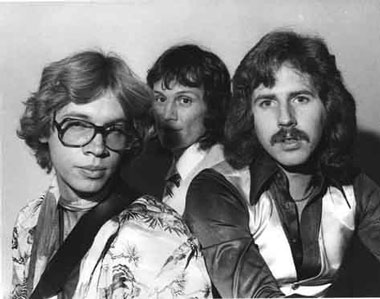
THE TWINKEYZ
Another
psychedelic proto-punk band of note, of course, was the Oklahoma
group Debris, with their mid-‘70s cult
LP Static Disposal. Debris had somewhat of a post-Roxy
Music sound (saxophone and synthesizer noise), suggesting
glam rock once again as something congruent with psychedelia.
Debris’ songs are sometimes comparable to the experimental
art metal of MX-80 Sound, but other times based more on grunge
rhythm guitar (having its basis, of course, in a psychedelic
group like Blue Cheer), with spacey riffing and soloing. Psychedelic-connoting
effects such as fuzz, phasing, and even what sounds like Echoplex
(the latter being a big Syd Barrett guitar playing allusion)
“add to the vibe.” “Boyfriend” may
have been Debris’ greatest track, with ridiculously
Echoplexed rhythm guitar and a far out, free form solo.
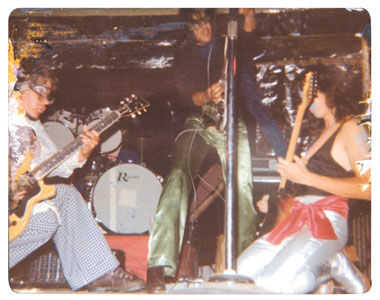
Ladies
and gentlemen, VICTORIA VEIN & THE THUNDERPUNKS, from
1974. This band evolved into the legendary Debris.....
Most
extreme of all is the recent two CD anthology of recordings
from 1975-85 by Pennsylvanian Todd Tamanend Clark
entitled Nova Psychedelia. Clark’s is quite
possibly the most psychedelic music ever created: sectional,
juxtapositional song structures like the wackiest of ‘60s
psych, but far more extreme and compositionally sophisticated,
getting into the six, seven, eight, and up to fourteen minute
range on tracks entitled “Origin,” “Phosphorescence
Is the Chamber,” “Brain and Spinal Column (Including
Animalism),” and “The Grim Rider.” Over
beautiful effects-processed (phase shifting, Echoplex) guitars,
heavy fuzztone guitars, synthesizers, Theremin (lots of Theremin),
‘60s garage organ, etc., Clark does Jim Morrison, “Horse
Latitudes”/”Celebration of the Lizard” style
recitations on practically every track!
Nova
Psychedelia begins with 1975-era material originally
released on one 45 and an eight-track tape, followed by the
entirety of Todd’s band the Eyes’ 1977 LP record
New Gods: Aardvark through Zymurgy. The remainder
of the set consists of everything from two more LPs and two
more singles. Todd’s 1979 LP We’re Not Safe
is perhaps somewhat reminiscent of the English band Pink Fairies
(if they had been demented enough to do a version of “I
Had Too Much to Dream (Last Night)” with gnarly Ted
Nugent-style lead guitar and mellotron or to write a fourteen
minute long, through-composed track!). The early ‘80s
LP Into the Vision is more of a solo affair that
is seemingly pretty top drawer among obscure, psychedelic-oriented
“minimal synth” records (along with Billy Synth’s
Music Is Forever EP, Dr. Mix and the Remix’s
Wall of Sound album, Rescue 1’s Movie Viewers
EP, etc.!).
In the
late ‘70s and early ‘80s, of course, the explicit
‘60s garage rock revival and Paisley Underground occurred,
and psychedelic aesthetics have persisted in American indie
rock (formerly known as “college radio music”)
since then. Whereas psychedelic-oriented punk (or, perhaps
more accurately, psychedelic-oriented post-punk)
and “basement” psych heaviness have been particularly
well represented in college radio music/indie rock over the
last couple of decades, a strain such as the “’70s
garage rock” of Creme Soda and Clap seems to have been
more of a momentary anomaly. If there is a greater lost music
discussed in this article, however, it is seemingly the ambitious
‘70s psychedelic pop of Zerfas, Trizo 50, Michael Angelo,
Bobb Trimble, etc. Good examples of this form persisting into
the ‘80s and falling outside of the post-punk framework
of college radio music/indie rock would be very interesting
to hear.
(Special
thanks to Karl Ikola, Jon Behar, Jack Dee, Bob DePugh, and
Wolf.)
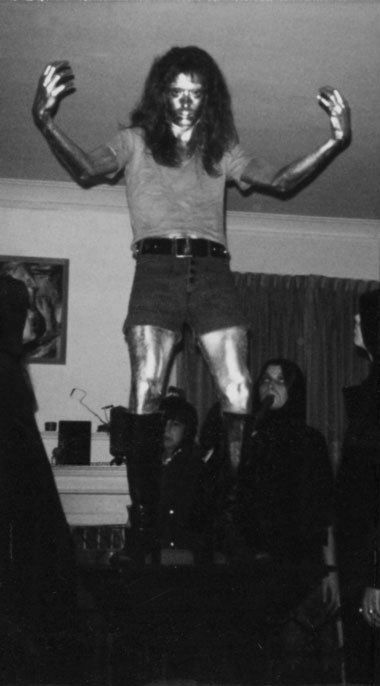
The one and only TODD TAMANEND CLARK bids you
a silvery adieu....

|